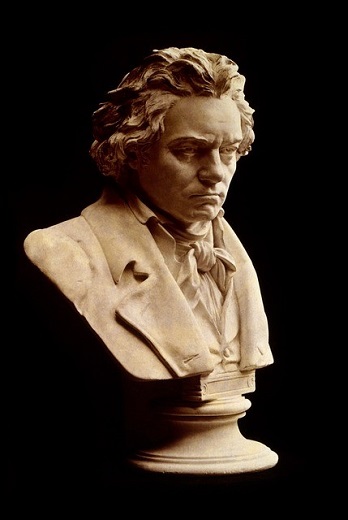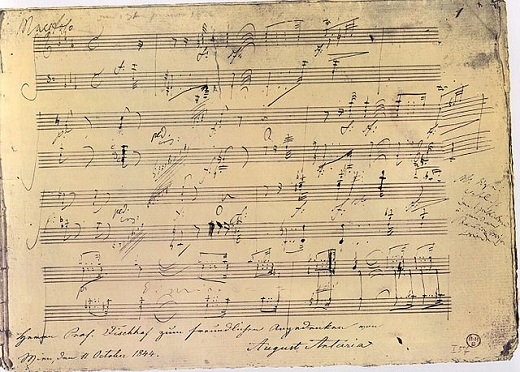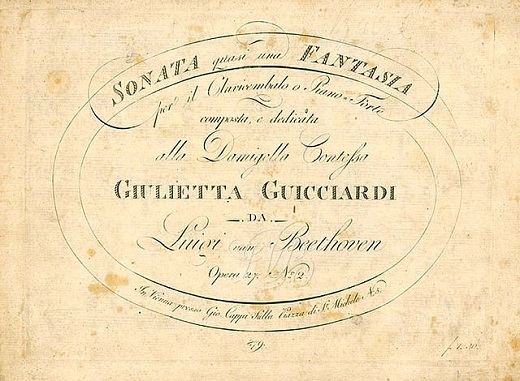
If you’ve reached the level where you can play sonatas, chances are you’ve studied at least one of Beethoven’s piano sonatas, haven’t you?
For those who are seriously studying piano, Beethoven’s piano sonatas are works that simply cannot be avoided. Among his piano compositions, the most important works are undoubtedly his piano sonatas.
Sonatas for keyboard instruments were also composed by Haydn and Mozart, who were active before Beethoven!
However, they did not write with the piano in mind; they primarily composed for instruments like the harpsichord or the clavichord.
In contrast, Beethoven composed on the piano and wrote with the piano specifically in mind. He was perhaps the first composer to create music purely for the piano, without considering other keyboard instruments.
This was closely related to the development of the piano as an instrument.
For Beethoven, the piano sonata was an extremely important genre. He didn’t compose these works only during a certain period of his life; he dedicated his entire career to them.
This time, I’d like to write about the difficulty ranking of Beethoven’s complete piano sonatas.
■ 目次
Many composers have left behind piano sonatas

Many composers have written piano sonatas. Let’s take a look at how many sonatas each composer has written.
[Number of Piano Sonatas by Composers Other Than Beethoven]
Haydn: 52
Mozart: 18
Chopin: 3
Schubert: 21
Schumann: 3
Liszt: 1
Prokofiev: 9
Rachmaninoff: 2
In addition to these, many other composers have written sonatas.
Note: Although Haydn and Mozart did not compose with the piano in mind, they are included here because their works are now performed on the piano.
Looking at the number of works, we can see that Haydn, who was active during the Classical period, wrote an especially large number of sonatas. In contrast, composers of the Romantic period (from Chopin to Liszt) wrote comparatively fewer sonatas, with the exception of Schubert.
One reason for the smaller number of sonatas after the Romantic period is the rise of character pieces and the ability to compose a variety of types of music.
Another reason may be the constraints of the sonata form itself.
Sonatas involve quite a few conventions, which may have felt restrictive for composers trying to express their thoughts through music.
This rigidity in form may have been one reason why fewer sonatas were composed after the Romantic period. (For more on sonatas and the sonata form, check out the articles on Sonatina Album Volume 1 and Sonatina Album Volume 2.)
How many piano sonatas did Beethoven compose?
We’ve seen how many sonatas other composers wrote, so how many did Beethoven compose?
He wrote 32 piano sonatas. Composers from the Classical period, such as Haydn and Mozart, composed many sonatas as well.
Beethoven also composed a significant number, with 32 works in total.
Over various periods of his life, while struggling with personal challenges, Beethoven continuously refined his piano sonatas, reflecting his feelings and the evolution of the piano. (For more on Beethoven’s struggles, see the article on the “Waldstein” Sonata.)
The 32 piano sonatas were composed and published gradually over time.
Because there are so many, modern publications typically divide them into two volumes. Some publishers even split them into three volumes.
Have you ever seen a score of Beethoven’s sonatas?
They’re incredibly thick and heavy… Carrying them to lessons can be quite a challenge.
In lessons, it’s common to study two or three pieces at a time, not just one. Adding Beethoven’s scores to the mix, along with two or three other books, turns it into a bit of a workout…
About the Periods and Characteristics of His Compositions

Beethoven’s works are generally divided into three periods: early, middle, and late. Let’s explore when the 32 piano sonatas were composed during these periods.
★Early Period (1782–1802)
The early period spans from Beethoven’s relocation to Vienna to the writing of the Heiligenstadt Testament. During this time, he was active as a pianist and gradually gaining recognition as a composer.It is said that the works from this period reflect the influence of Haydn and Mozart.
In terms of piano sonatas, Beethoven seemed to aim for larger-scale works, as many of them include four movements. (Previously, three-movement sonatas were the standard.)
● Piano Sonatas Composed: Nos. 1 to 11 (11 works)
● Representative Piano Sonata of the Early Period: No. 8 “Pathétique”
★Middle Period (1802–1816)
The middle period starts after Beethoven wrote the Heiligenstadt Testament and ends when he became the guardian of his nephew Karl.Works from this period no longer show the influence of Haydn and Mozart. Instead, Beethoven’s individuality and distinctive style become more apparent.
Although his hearing continued to deteriorate, this period is considered the most prolific and creatively fulfilling.
● Piano Sonatas Composed: Nos. 12 to 27 (16 works)
● Representative Piano Sonatas of the Middle Period: No. 14 “Moonlight”, No. 17 “Tempest”, No. 21 “Waldstein”, No. 23 “Appassionata”, No. 26, “Les Adieux”
★Late Period (1816–1827)
The late period spans from the time Beethoven became the guardian of his nephew Karl until his death. This was a time of great personal struggle, including his strained relationship with Karl and his worsening hearing.It is said that the works of this period delve even deeper into introspection compared to the middle period.
● Piano Sonatas Composed: Nos. 28 to 32 (5 works)
● Representative Piano Sonata of the Late Period: No. 29 “Hammerklavier”
The creative output of the middle period, following the writing of the Heiligenstadt Testament, is truly astounding! Most of Beethoven’s famous sonatas were composed during this time. It’s incredible how he overcame his struggles and transformed them into a driving force for creativity!
Did Beethoven Name These Titles Himself?

Many of Beethoven’s 32 piano sonatas are referred to by their titles rather than their opus numbers. Let’s take a look at the sonatas commonly called by their titles.
◆ Sonatas Referred to by Titles
Sonata No. 8 “Pathétique”, No. 12 “Funeral March”, No. 14 “Moonlight”, No. 15 “Pastoral”, No. 17 “Tempest”, No. 21 “Waldstein”, No. 23 “Appassionata”, No. 24 “Thérèse”, No. 26 “Les Adieux”, No. 29 “Hammerklavier”These ten sonatas are likely the ones most commonly known by their titles.
Out of these, the titles given by Beethoven himself are only No. 8 Pathétique and No. 26 Les Adieux.
As for Pathétique, it’s not entirely clear whether Beethoven himself came up with the title. However, since the title was already present in the first edition, it’s believed that even if he didn’t name it himself, he likely approved of it.
The other titles are nicknames. Let’s explore the origins of these nicknames.
◆ Origins of Nickname Titles
● No. 12 “Funeral March”: The third movement is a “Marche funèbre,” and this is why the entire sonata is referred to as “Funeral March”.● No. 14 “Moonlight”: Nos. 13 and 14 are titled “Sonata quasi una fantasia.” The nickname “Moonlight” originated from a comment by Ludwig Rellstab, a German poet and music critic, who compared the piece to “a boat floating in the moonlight on Lake Lucerne in Switzerland.”
● No. 15 “Pastoral”: This nickname was added when the publisher Cranz in Hamburg included “Sonate pastrale” during a reissue in 1838.
● No. 17 “Tempest”: When one of Beethoven’s students asked him about the interpretation of this piece, Beethoven replied, “Read Shakespeare’s The Tempest.” This led to the nickname.
● No. 21 “Waldstein”: The sonata was dedicated to Count Waldstein, which gave it its title.
● No. 23 “Appassionata”: The nickname came from the publisher Cranz, who labeled it as such when he arranged the piece for piano four hands in 1838.
● No. 24 “Thérèse”: The title derives from its dedication to Countess Thérèse von Brunsvik.
● No. 29 “Hammerklavier”: Beethoven instructed Steiner & Co. to use the German term “Große Sonate für das Hammerklavier” (Grand Sonata for the Hammerklavier) instead of “pianoforte” for his works starting from Op. 101. However, only No. 29 is specifically referred to as “Hammerklavier”.
Not just for Beethoven, but for many composers, there are cases where the titles were not given by the composers themselves.
For pieces without composer-given titles, it’s thought that the composers avoided giving titles because they didn’t want the music’s interpretation to be restricted by specific imagery.
However, for listeners, having a title often makes a piece easier to remember and visualize.
Whether composer-given or nicknamed, pieces with titles tend to be more widely recognized and are often among the most famous works.
Difficulty Ranking of All the Pieces
As for the sheet music, I believe many people use the Henle edition. I also use the Henle edition.
I’ve been studying with the Henle edition, but recently my teacher recommended the Schnabel edition, so I’m planning to purchase it.
Now, let’s look at the difficulty ranking of the 32 piano sonatas!
I’ll provide two types of rankings: one for all the pieces and one for only the famous ones.
● Difficulty Ranking of All Pieces
・Difficulty is represented by the number of ★, and the pieces are divided into 10 levels.
・The numbers correspond to the sonata numbers.
・Pieces with the same difficulty level are arranged in ascending numerical order.
★ No. 20 in G Major, Op. 49-2
★★ No. 19 in G Minor, Op. 49-1
★★★ No. 25 in G Major, Op. 79
★★★★ No. 5 in C Minor, Op. 10-1
No. 6 in F Major, Op. 10-2
No. 10 in G Major, Op. 14-2
★★★★★ No. 4 in E-flat Major, Op. 7
No. 8 “Pathétique” in C Minor, Op. 13
No. 9 in E Major, Op. 14-1
★★★★★★ No. 1 in F Minor, Op. 2-1
No. 7 in D Major, Op. 10-3
No. 11 in B-flat Major, Op. 22
No. 13 in E-flat Major, Op. 27-1
No. 16 in G Major, Op. 31-1
No. 18 in E-flat Major, Op. 31-3
★★★★★★★ No. 2 in A Major, Op. 2-2
No. 3 in C Major, Op. 2-3
No. 15 “Pastoral” in D Major, Op. 28
No. 22 in F Major, Op. 54
No. 24 “Thérèse” in F-sharp Major, Op. 78
No. 27 in E Minor, Op. 90
★★★★★★★★ No. 12 “Funeral March” in A-flat Major, Op. 26
No. 14 “Moonlight” in C-sharp Minor, Op. 27-2
No. 17 “Tempest” in D Minor, Op. 31-2
No. 28 in A Major, Op. 101
No. 30 in E Major, Op. 109
No. 31 in A-flat Major, Op. 110
★★★★★★★★★ No. 21 “Waldstein” in C Major, Op. 53
No. 23 “Appassionata” in F Minor, Op. 57
No. 26 “Les Adieux” in E-flat Major, Op. 81a
No. 32 in C Minor, Op. 111
★★★★★★★★★★ No. 29 “Hammerklavier” in B-flat Major, Op. 106
● Difficulty Ranking of Famous Pieces Only
★★★★★ No. 8 “Pathétique”
★★★★★★★ No. 15 “Pastoral”, No. 24 “Thérèse”
★★★★★★★★ No. 12 “Funeral March”, No. 14 “Moonlight”, No. 17 “Tempest”
★★★★★★★★★ No. 21 “Waldstein”, No. 23 “Appassionata”, No. 26 “Les Adieux”
★★★★★★★★★★ No. 29 “Hammerklavier”
Looking at the overall rankings, you can see that the difficulty order does not correspond to the numerical order of the sonatas.
Beethoven’s piano sonatas are not only technically challenging but also difficult in terms of interpretation.
You need to play with precise articulation, but it shouldn’t sound as light as Mozart, nor should it simply be played heavily.
When performing Beethoven’s sonatas, it’s crucial to follow the dynamics closely. Play the intense sections with passion!
This dramatic contrast in dynamics might reflect his turbulent temperament. A calm person probably wouldn’t make such abrupt changes.
However, this very intensity is characteristic of Beethoven and part of his appeal. Expressing oneself within a composition connects to the Romantic era that followed.
Hans von Bülow, a conductor and pianist, referred to Beethoven’s piano sonatas as the “New Testament” of music. (The “Old Testament” being Bach’s Well-Tempered Clavier.)
This demonstrates just how significant Beethoven’s piano sonatas are among piano works.
Sonatas with titles are performed by piano students, but they are also played by pianists in recitals and recorded on CDs.
While there are many pieces that both students and professional pianists play, it’s rare for pieces outside of Beethoven’s piano sonatas to be featured as the main work in a recital.
This speaks to how these sonatas are both technically demanding and substantial in content.
Beethoven’s sonatas may not be the most enjoyable to play, but they are incredibly educational!
Use this difficulty ranking as a reference and take on your favorite piece!
Summary
◆ Beethoven was a composer who composed on and for the piano.◆ The Classical period produced a large number of sonatas, while the Romantic period and later saw fewer sonatas.
◆ Beethoven wrote 32 piano sonatas.
◆ His works are divided into three periods: early, middle, and late.
◆ The middle period was the most prolific.
◆ Beethoven personally titled only two of his sonatas: No. 8 Pathétique and No. 26 Les Adieux.
◆ The difficulty ranking does not follow the numerical order of the sonatas.
- IMSLP
No. 1 (Score Link) No. 2 (Score Link) No. 3 (Score Link) No. 4 (Score Link) No. 5 (Score Link) No. 6 (Score Link) No. 7 (Score Link) No. 8 (Score Link) No. 9 (Score Link) No. 10 (Score Link) No. 11 (Score Link) No. 12 (Score Link) No. 13 (Score Link) No. 14 (Score Link) No. 15 (Score Link) No. 16 (Score Link) No. 17 (Score Link) No. 18 (Score Link) No. 19 (Score Link) No. 20 (Score Link) No. 21 (Score Link) No. 22 (Score Link) No. 23 (Score Link) No. 24 (Score Link) No. 25 (Score Link) No. 26 (Score Link) No. 27 (Score Link) No. 28 (Score Link) No. 29 (Score Link) No. 30 (Score Link) No. 31 (Score Link) No. 32 (Score Link)
All of these are public domain scores published by Breitkopf & Härtel between 1862 and 1890.
- ピアノ講師直伝☆ベートーベン悲愴第2楽章♪難易度と弾き方コツ4つ! 2017年3月11日
- 初めてベートーベンを弾く人へ♪ソナタ19番ト短調Op.49-1の弾き方と難易度 2017年6月21日
- ベートーベン「ソナタ17番テンペスト第3楽章」ピアノの難易度と弾き方 2017年6月23日
- 悲愴感いっぱいに弾きたい曲!ベートーベン「ソナタ第8番悲愴第3楽章」ピアノの難易度と弾き方 2017年7月1日
- 苦悩の人!ベートーヴェン「ワルトシュタイン」第1楽章の弾き方と難易度 2017年7月26日
- Beethoven’s Complete Piano Sonatas Ranked by Difficulty: The Ultimate Guide for Pianists! 2017/8/10 ←Currently Viewing Article
- ベートーヴェン「悲愴(第一楽章)」難易度と上手な弾き方の3つのコツ 2017年9月2日
- cantabileしてみる!ベートーヴェン「悲愴(第二楽章)」弾き方のコツと難易度! 2017年9月7日
- ピアノソナタの代表格!ベートーヴェン「月光ソナタ」弾き方と難易度 2018年1月7日
- ベートーヴェンの「月光」第一楽章の魅力。難易度と弾き方の解説 2018年4月27日
- 活発に!ベートーベン『ソナタ第20番ト長調op.49-2第1楽章』の弾き方と難易度 2018年8月28日
- ベートーベン「ピアノソナタ第10番第1楽章」難易度と弾き方のポイント 2018年10月25日
- 初級者向け!ベートーベン:ソナタ第20番ト長調op.49-2第2楽章の弾き方と難易度 2018年11月9日
- ベートーヴェン「熱情ソナタ」の難易度と弾き方を解説!~ピアノソナタ第23番ヘ短調作品57 2019年1月16日
- かっこうの鳴き声が聞こえるソナタ、ベートーヴェンソナタ25番第1楽章の弾き方と難易度 2019年1月24日
- ベートーベン「ピアノソナタ第1番第1楽章Op.2-1」難易度と弾き方は? 2019年2月23日
- べートーヴェン「ピアノソナタ第26番『告別』」全楽章の弾き方と難易度を解説!! 2019年4月14日
- ベートーベン「ピアノソナタ第1番第4楽章Op.2-1」の難易度と弾き方は? 2019年6月8日











